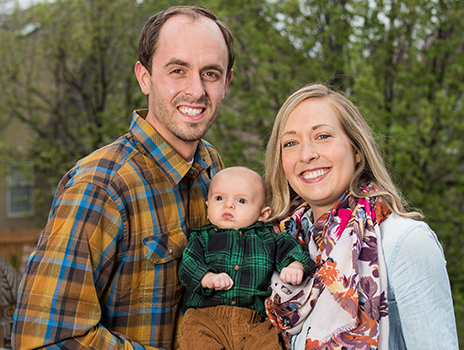- Home
- News Room
- Patient Stories Search Page
- Persistence Pays off for Young Colorectal Cancer Patient
August 13, 2019
At age 24, Ashley Flynn fought a difficult diagnosis of advanced colorectal cancer. More recently, she battled a stream of emotions and expectations going through in vitro fertilization to become pregnant.
Today, she puts all those struggles into perspective, as she celebrates being cancer-free for 5 1/2 years and motherhood to her son, Samuel Robert, born January 27.
“It’s important to never lose hope,” she says.
Ashley always knew she wanted a family. Prior to going through chemotherapy and radiation for colon cancer, she took the necessary steps to preserve her fertility. She had her ovaries detached from her fallopian tubes and reattached to her abdominal oblique muscles. The procedure was intended to shield the ovaries from radiation and allow them to remain viable so that Ashley would be able to attempt pregnancy in the future.
After she and Shawn Flynn married in June 2015, they launched into learning about IVF. They entered into the process in January 2016 with Courtney Marsh, MD, MPH, who specializes in reproductive endocrinology and infertility at The University of Kansas Health System.
Dr. Marsh vividly recalls the events leading up to the birth of the Flynns' baby. In fact, she has a photo of Samuel on her desk next to her own sons.
“This was an amazing case,” says Dr. Marsh. “Ashley had radiation to her uterus and high doses of chemotherapy, which are toxic to the ovaries. One of her ovaries had fallen and gone into failure. She had scar tissue from her treatment and surgeries. We didn’t have a lot of women who had gone through so much at such a young age.”
Ashley, who is a nurse practitioner and works in hematology/oncology at Children’s Mercy Hospital, knew there would likely be hurdles along the way. Still, she persisted and was hopeful.
It just takes one
Initially, Dr. Marsh was able to locate only one ovary. With her right ovary pinpointed, Ashley began the 2-week series of twice daily injections to increase follicle production. Dr. Marsh monitored her follicle production with ultrasound scans every 2 days.
Then Ashley had surgery to retrieve the follicles, which were fertilized and left to grow for 5 days before being implanted. They had hoped to retrieve 12 follicles but only got 2 because the ovary had hardened. Sadly, the embryos did not survive, dashing the couple’s hopes.
A turn of events occurred when Ashley had another ultrasound scan of her abdomen a few weeks later.
“I turned on my side and Shawn said to the sonographer, 'What was that? It looks like an ovary,'" Ashley recalls. “Dr. Marsh looked and said, ‘Yes, that’s your (other) ovary.’ It was hard to detect because it was pinned up high by my kidney.”
Ashley eagerly launched into the follicle production process for her left ovary. While the result was plentiful, with 12 potential eggs, retrieving them posed a new challenge because of the ovary’s location.
“We didn’t know if retrieval was possible,” says Dr. Marsh, who typically recovers follicles through a transvaginal procedure. “It was very risky and there was a chance we could puncture her kidney.”
Dr. Marsh called in the expertise of an interventional radiologist to perform a transabdominal retrieval. The procedure had never been done here before.
Interventional radiology centers on image-guided, minimally invasive procedures. Interventional radiologists commonly use ultrasound guidance to target very small lesions for biopsy, so targeting the ovary in the same way was straightforward.
The interventional radiologist was able to safely guide the needle through her abdomen into the ovary that could not be accessed in any other way. This helped her avoid a major operation and allowed her to go home the same day.
“Once the interventional radiologist reached the ovary, we worked together to retrieve her follicles,” says Dr. Marsh. “I had never done this. He had never done this. But we wanted to do all we could to get Ashley pregnant.”
From the 12 eggs retrieved, 10 were mature. Of the 10, 7 were fertilized. After the 5-day growing period, 3 embryos remained for genetic testing. To ensure all the embryos were genetically sound, all 3 were tested. One was normal.
“There was just a 60% chance for pregnancy with a normal embryo,” says Dr. Marsh. “Our entire clinic was ecstatic. Working with interventional radiology, we have a recipe for success.”
From heartbreak to happiness
“Even though we only had 1 embryo, it resulted in our beautiful baby boy,” says Ashley, adding that she will need to repeat IVF to have more children.
Once Shawn and Ashley heard Samuel’s heartbeat for the first time, Ashley’s care was transferred to an obstetrician at another healthcare facility and she became “a normal patient.” After an uncomplicated pregnancy, Samuel made an early arrival on January 27, 2017, weighing 6 pounds 4.7 ounces.
“Colorectal cancer screening and IVF are sensitive topics, but I believe the more people are informed and aware, the better,” she says. “Throughout both cancer treatment and IVF, it’s important to never lose hope.”
